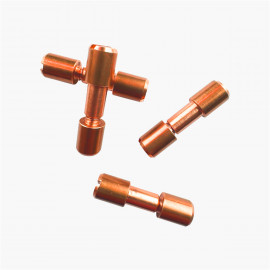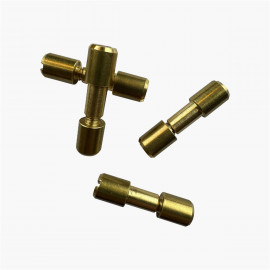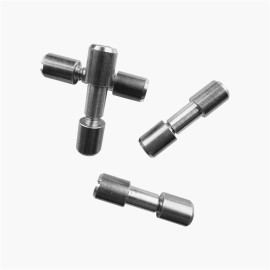Corby rivets of brass, stainless steel or copper
Corby Rivets: Robust and aesthetic fastening for your knife sleeves
In cutlery, fastening the handle is an essential step that determines both the strength, ergonomics and elegance of the finished knife. Corby rivets are a particularly popular solution for artisans and cutlery enthusiasts to assemble the sleeve pads in a sustainable way. Thanks to their unique design, they ensure reliable and aesthetic assembly while allowing different finishes according to user preferences.
Available in copper, stainless steel and brass, these rivets offer great flexibility in the choice of materials and finishes. They provide a sober and modern look or, on the contrary, a natural patina over time, depending on the desired effect. This fastening system, while being simple to implement with a little bit of detail, guarantees a robust and durable hold of the pads on the blade.
The benefits of Corby rivets for cutlery
Corby rivets are composed of two distinct parts: one male and one female, which screw one in the other to ensure optimal maintenance. This mechanism makes it possible to create a solid assembly without resorting to a conventional riveting that requires a hammering.
One of the main assets of these rivets is their ability to ensure extremely resistant to shocks and vibrations. Unlike classic rivets, they ensure excellent mechanical handling while offering a neat finish after sanding and polishing.
Another significant advantage is that their implementation allows for two different types of finishes. It is possible to keep the traces of visible screws in order to allow possible dismantling and subsequent maintenance of the knife. For a more homogeneous and aesthetic finish, the heads of the screws can be ground and polished until they are invisible, giving the illusion of full riveting.
These rivets are also particularly suitable for the sleeves of art and collection knives, where aesthetics plays a central role. They integrate perfectly with different types of materials, such as stabilized wood, tinted magnifying glass or composite materials such as micarta or carbon fiber.
Choose its Corby rivets: copper, stainless steel or brass?
The choice of Corby rivet material plays an essential role both aesthetically and functionally. Each metal has its own features and advantages depending on the use of the knife and the style sought.
Corby brass rivets are particularly appreciated for their classic appearance and natural patina that evolves over time. They offer excellent corrosion resistance, making it a preferred choice for precious or stabilized wooden sleeves. Their golden hue perfectly harmonizes with the warm shaded wood, bringing an elegant and refined contrast.
Corby rivets in stainless steel they are particularly suitable for kitchen knives or outdoor knives, which are subjected to humid environments. Unalterable and extremely resistant to corrosion, they guarantee lasting fixation without risk of rust. Their brilliant finish brings a touch of modernity and sobriety, ideal for contemporary creations.
Corby copper rivets seduce by their warm color and their ability to develop a unique patina over time. Their reddish colour brings a striking contrast when associated with dark wood or composite materials. They are ideal for knives with vintage or rustic design, where aesthetics plays an essential role.
How to install Corby rivets on a knife handle?
The assembly of the sleeves with Corby rivets is based on careful preparation in order to obtain a perfect fit and optimal support. Several steps are essential to ensure a solid and aesthetic result.
-
Preparation of sleeve pads
Before installing the rivets, it is important to drill the pads from the handle to the diameter of the Corby rivet axis. This operation must be carried out precisely to ensure perfect alignment and avoid any play between the elements. -
Creation of houses for screw heads
Once the first drilling is done, the holes should be milled lightly to allow the screw heads to recess correctly. A suitable lamer cutter or drill is recommended to obtain a well-fitted support surface. -
Mounting and tightening of rivets
Both parts of the Corby rivet must be screwed together by firmly holding the pads against the silk of the knife. It is essential to ensure a moderate but firm clamping, ensuring that the heads of the rivets come into contact with one another to ensure a solid assembly. -
Sleeve finish
Depending on the desired effect, it is possible to leave the screw heads visible or grind them to obtain a completely smooth rendering. In the latter case, the excess material should be cut and sanded gradually before final polishing.
Considerable attention must be paid to the depth of housing drilling, in order to preserve sufficient material to ensure proper maintenance. Using a drilling guide can be useful to ensure a homogeneous depth and avoid weakening the handle.



